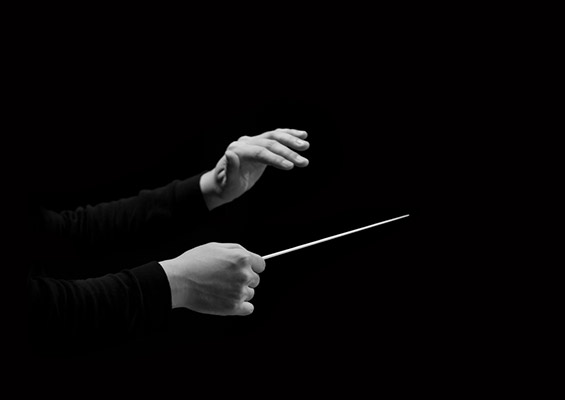
The Fixation on Beating Patterns as the Primary Starting Point for Conducting Teaching
The above video with Marin Alsop, giving a to-camera introduction to time-beating in 4/4, is typical of the pedagogy used in introducing the Art of Conducting to beginner students irrespective of the age at which they begin learning.
The problem is that beating in 4/4 is neither artful nor does it represent conducting as an artform. So why do conductors – both who are pedagogues and/or active working conductors – perpetuate this model and ingrain the idea of beat patterns as the primary means of communication between conductor and orchestra from the outset?
I have always found it notionally ludicrous that orchestral musicians playing under a conductor apparently can’t count up to four (or 2 or 3 etc.) once shown the tempo at which the musical passage begins. Alsop is correct that for the players, as opposed to the audience, the initial movement of the conductor – in this case, the ubiquitous raising of the right arm in an upward vertical-like movement – is critical to the information that the players need to time when the actual sound of the music will begin and, how quickly or slowly the music will then proceed.
More on why this preparation movement is almost invariably ‘upwards’ – and why it is often the worst thing a conductor can do later.
But, the issue remains, after this visual/physical has been given the orchestra players don’t need any further timing information to perform the notes and dynamics of the music until there is a change in the tempo in the music itself to be conveyed by the conductor (but, in fact, is often agogically given by the concertmaster when a conductor mismanages this critical aspect of their role).
Why, therefore, is the concept of time-beating perpetuated as the basis of conducting in performance when it is the least important aspect of conveying musical interpretation to players in an orchestra?
My view is that this approach has become ingrained in methodologies of teaching which have been passed down from the old conducting treatises dating back to the late 19th Century, as epitomised in the didactic teachings of Richard Wagner and Felix Weingartner to mention just two of the prominent culprits. Mid-century texts by Rudolf, Malko, and Green et al generally pursued similar aesthetic approaches to greater or less tedium.
As the predominant textbooks have perpetuated the primary concept of musical expression of a conductor to be derived from the exacting study of combinations of beat-pattern patterns which, when expertly ‘melded’, combine to create the fluid movements of a conductor into a seamless representation of the music being performed as physical gesture, so too have we witnessed multiple generations of conductors looking like traffic policeman and policewomen directing vehicles in front of orchestral ensembles.
Various alternative approaches to finding a better means for conductors to impart more precise, nuanced and detailed musical ideas to an orchestral ensemble have been developed, but they are difficult for students starting out to discern or even identify. Equally, there are conductor/teachers who have developed new techniques for developng such skills albeit the conceptual basis in respect to teaching aesthetic varies considerably.
Here is one conceptual idea for the preparatory beat and movement of the right arm to start a piece of music that you often see in conductors not fixated on beat patterns (think Gennady Rozhdestvesnky, Carlos Kleiber, Jascha Horenstein, Andre Cluytens and contemporaries such as Lahav Shani):
Start the preparation for the downbeat (assuming beat 1 is the start of the music) moving from above the left shoulder at the point of beat 2 in a 4/4/ pattern moving sideways left-to-right in a horizontal motion with the downbeat ending out to the right of the body relative to beat in 3 in a standard textbook 4/4 pattern. Result: a downbeat that is not vertical and is not displaced downwards. Consequence: “one is not always down”. Of course, such a preparation and downbeat would only make musical and physical sense if the primary sound is to begin in the lower tessitura instruments of the ensemble and assuming they are on the right-hand side of the conductor as (s)he faces it.
Thinking in horizontal planes and not only vertical planes opens up an endless vista of conducting gesture possibilities in three dimensions.
Whereas, a detailed list of the worst culprits in terms of published methodologies about conducting technique grounded in beat patterns ultimately only represents my opinion (and many conductors will disagree with me) I do hold to the opinion that young and experienced conductors alike should read everything on the subject that they can access. Over time one learns to separate what is valuable and to absorb those ideas that work for each individual.
Nonetheless, let me mention a couple of resources that I do believe are worth pursuing. Here’s a very short list:
- Embodied Conducting as taught by Charles Gambetta. Charles teaches workshop based on this technique and his teaching is excellent.
- Score Study Passes by Lawrence Golen is a concise but highly effective methodology on the thorough and systematic approach to preparing scores for rehearsal and performance.
- The Techniques of Orchestral Conducting by Ilia Musin (trans. Oleg Proskurnya) is an English translation of the conducting methodolgy of Professor Ilia Musin, the creator of the “Leningrad/St. Petersburg school of conducting. This is one of very few book on conducting teaching (which includes beat patterns) that has real merit. It is, admittedly, more easily understood by advanced students and professional conductors.
